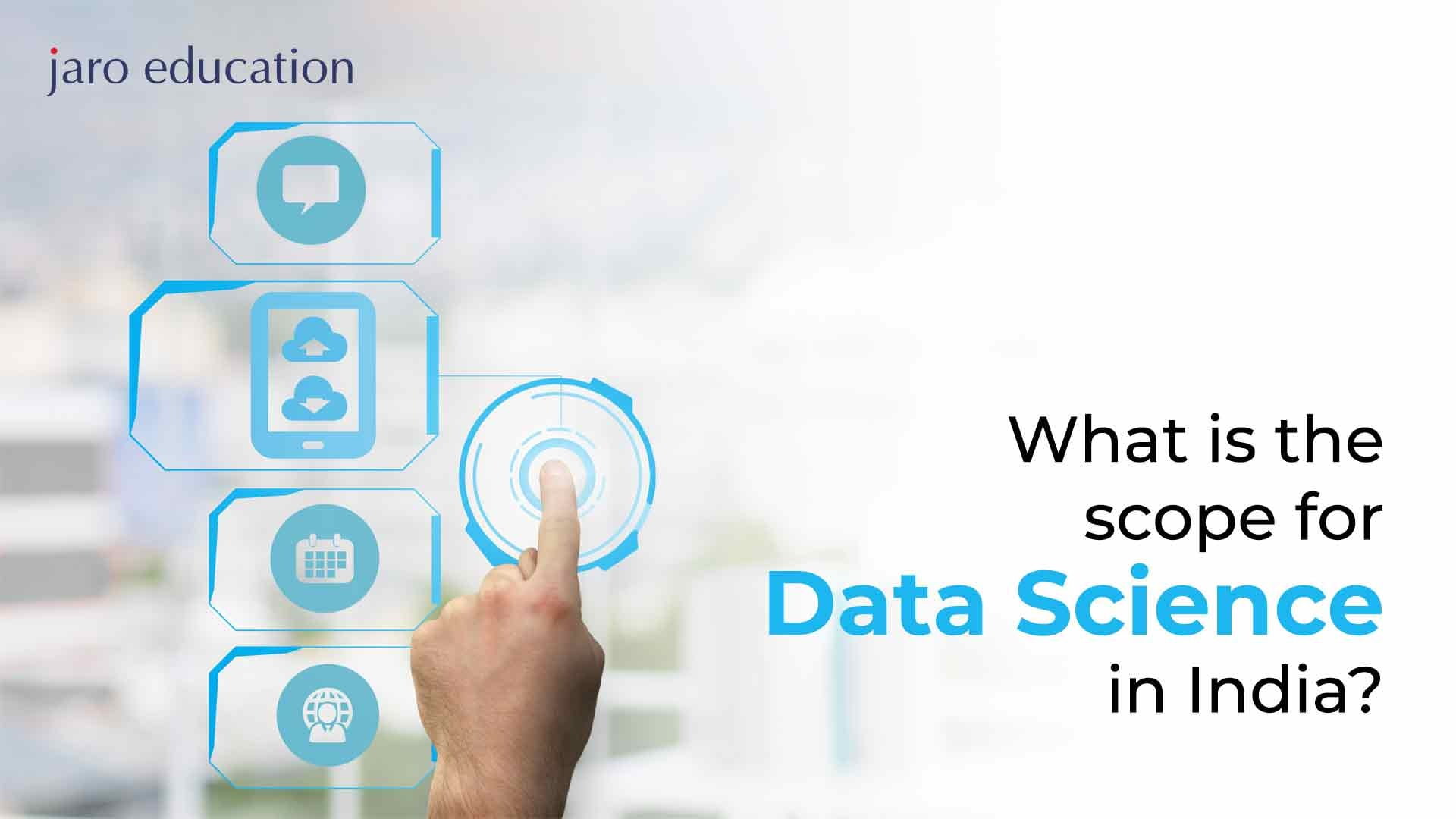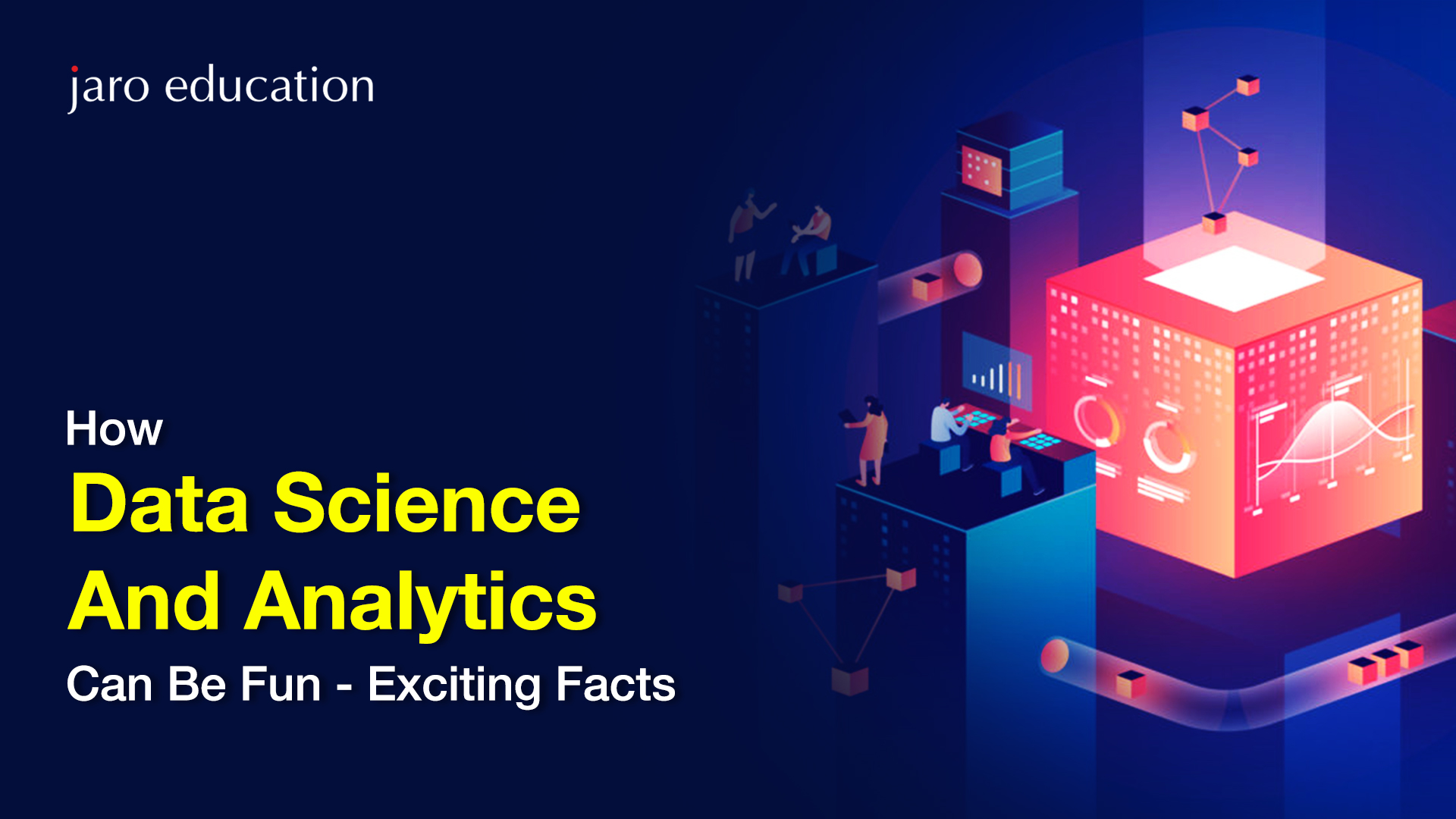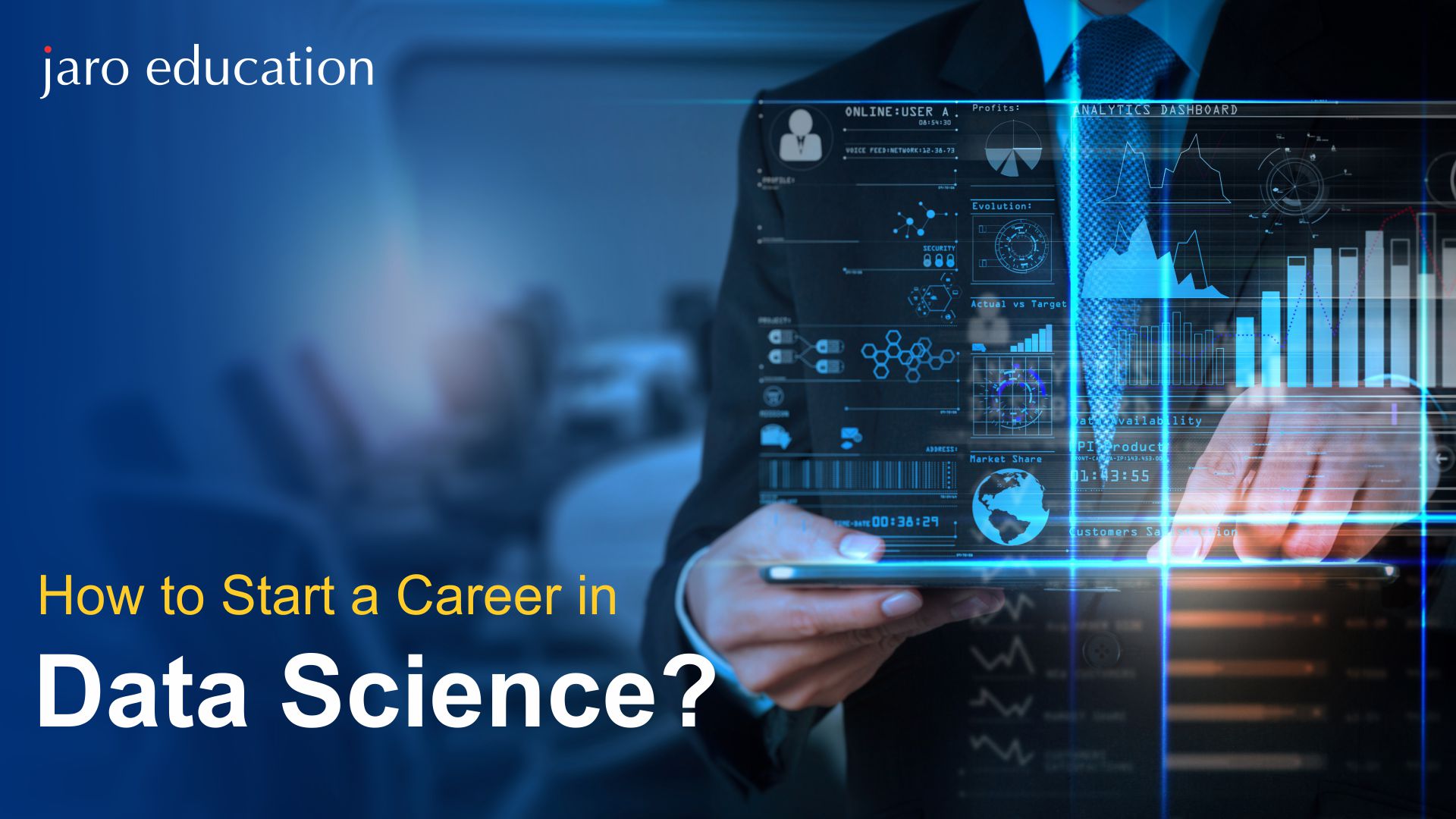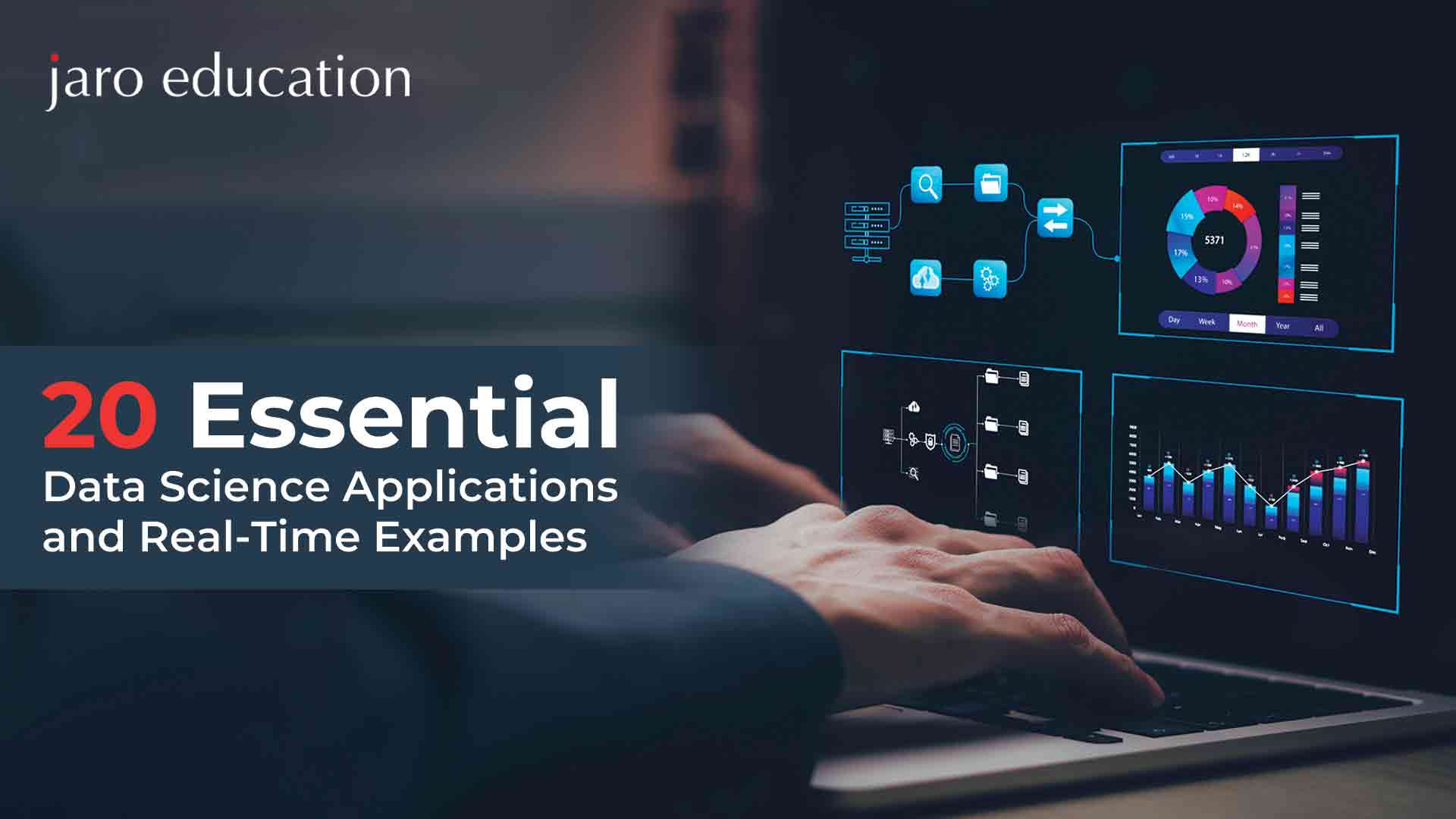
- jaro education
- 19, February 2024
- 1:00 pm
In the current digital age, every industry heavily relies on data science. Data science and applications help businesses make smarter decisions, effectively align market resources and understand the market better. Data science is the in-depth study of huge amounts of data which involves retrieving meaning from unstructured, raw and structured data. Extraction of these data from various sources requires data processing, which can be accomplished by using statistical techniques and algorithms, scientific methodologies, various technologies, and so on. It employs a variety of tools and strategies to extract useful information from raw data.
Many individuals show interest in learning about data science applications and examples that can be used in different businesses. Here are some essential data science applications and real-time examples that can help people understand this area of study.
Table of Contents
Top Data Science Applications
There are various data science applications used by numerous businesses that help teams and managers in strategic planning and decision-making. The top 10 applications of data science are as follows:
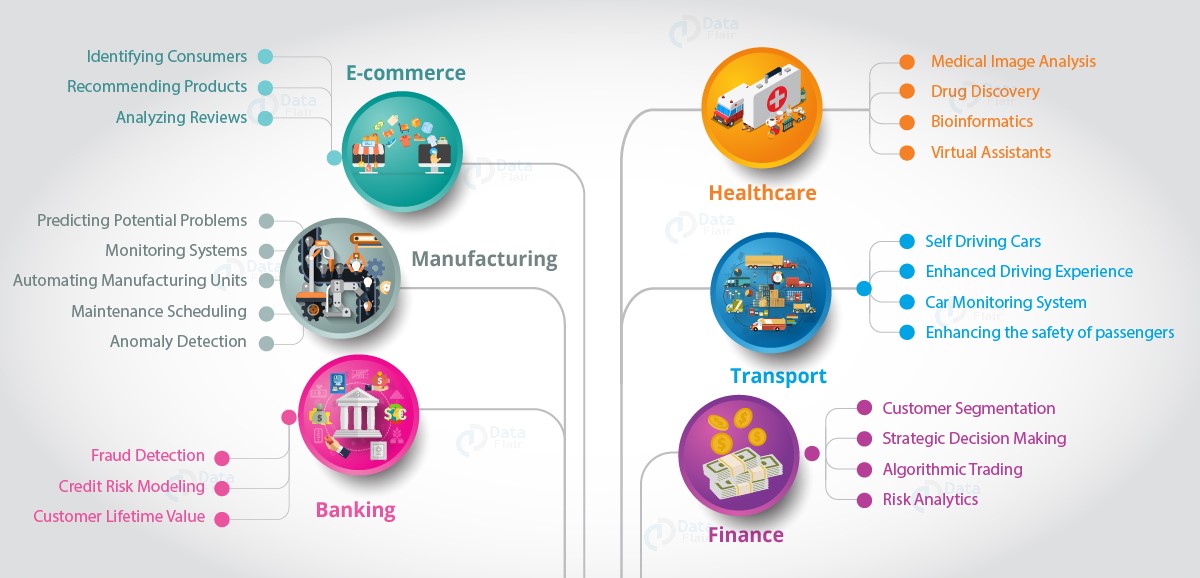
*data-flair.training
1. Medical Image Analysis
Data science applications in healthcare or medical research have a variety of functions. Analyzing medical pictures is one of them. Data science and machine learning may be used to identify atherosclerosis, cancer, organ delineation, and other problems in pictures. With more datasets and images, physicians can diagnose patients more effectively using machine learning. One of the data science examples in healthcare would be the use of Merative. It is a tool that enables healthcare organizations to track data. Their algorithms can effectively detect abnormalities and illnesses, allowing for earlier diagnosis and more successful treatment planning. Furthermore, data science allows for the collection and analysis of vast amounts of patient data, which aids healthcare practitioners in identifying patterns and risk factors connected with specific diseases.
2. Natural Language Processing
The discipline of Natural Language Processing (NLP) has been drastically influenced by data science as it allows robots to comprehend, interpret, and synthesize human language. NLP tasks include sentiment analysis, language translation, text summarisation, chatbots, and speech recognition. Data science approaches, particularly machine learning and deep learning algorithms, have contributed significantly to the advancement of NLP capabilities. For example, large datasets are used by Microsoft’s Cortana, Apple’s Siri and Google’s Voice, all of which are powered by data science and natural language processing (NLP) algorithms; as more data is analyzed, speech recognition software advances and gains a better understanding of human nature through data science applications.
3. Financial Fraud Detection
Data science applications usage in banking is rapidly changing the face of the financial industry. Finance includes a variety of data science applications. Fraud detection is one of them, and it will improve and strengthen in the future. Data science applications in finance are inextricably linked because data analysts may spot trends in data that lead to several fraud situations. Machine learning and artificial intelligence algorithms, in particular, have resulted in more adaptable and resilient fraud detection systems. Data scientists may create prediction models for real-time transactions by analyzing massive volumes of past transaction data. Furthermore, data science allows for the integration of many data sources, including transaction records, consumer behavior data, device information, and social network data, to create comprehensive profiles of customers and their actions.
4. Sports Analytics
Sports Analytics has a tremendous influence on data science, changing how organizations, coaches, and athletes evaluate performance and make strategic decisions. With the massive amounts of data accessible via sensors, cameras, and wearables, data science approaches allow for the extraction of useful insights and patterns. Data science is used mostly in sports analytics to analyze player performance. Data scientists analyze player data using advanced statistical methods and machine learning algorithms, which include movement patterns, shot accuracy, and other performance indicators. This analysis assists coaches in determining the strengths and weaknesses of individual players and the team as a whole, resulting in data-driven training programs and tactical plans.
5. Predictive Maintenance
In the field of predictive maintenance, data science has a transformational role. It allows enterprises to shift away from reactive and preventative maintenance tactics and towards more proactive and cost-effective ways. Predictive Maintenance uses data science approaches to analyze sensor data, machine logs, and other relevant data sources in order to forecast equipment faults before they happen. Data science also allows for the optimization of maintenance schedules based on equipment health and consumption trends, resulting in more efficient maintenance procedures.
6. Retail Market Analysis
Data science has had a significant influence on retail market analysis, offering retailers strong tools and insights to help them better understand customer behavior, optimize operations, and make data-driven choices. Customer analytics is a prominent use of data science in retail. Data scientists may develop client profiles and segments by combining data from a variety of sources, including transaction records, customer loyalty programs, and internet interactions. This allows merchants to identify their most valued consumers, learn about their preferences, and personalize marketing campaigns to specific customer categories.
7. Climate Change Analysis
Data science plays an important part in climate change analysis by using data-driven methodologies to analyze, simulate, and predict the complex interactions that occur within the Earth’s climate system. To analyze climate change patterns and trends, data scientists employ a variety of data sources such as satellite images, weather station data, oceanic data, and climate models. Machine learning algorithms are used to discover climate trends, detect abnormalities, and forecast future climate conditions. These models enable researchers and policymakers to obtain vital insights into the forces driving climate change, assess its environmental effect, and develop mitigation and adaptation policies.
8. Social Media Analysis
Social media analytics is now several notches advanced for the involvement of data science. Companies and scholars can glean important insights from the massive amounts of data created by social media platforms with data science’s involvement. Data scientists analyze social media data, such as text, photographs, and videos, using a variety of data mining and natural language processing techniques.
Sentiment analysis is one of the popular data science applications in this sector, with machine learning models used to assess the sentiment of social media postings, comments, and reviews. This allows organizations to better understand public image, consumer feedback, and brand sentiment. Furthermore, data science is essential for monitoring and analyzing social media trends. Data scientists may detect new themes, popular hashtags, and viral content by evaluating real-time data streams, allowing businesses to communicate with their target audience and adjust their marketing tactics appropriately.
9. Image & Video Analysis
The area of image and video analysis has witnessed a revolutionary change with the advancement of data science. With its help, robots can analyze visual information, recognize objects, and comprehend complicated scenarios. Deep learning, a type of machine learning, has been a key factor in the development of image and video analysis applications. Convolutional Neural Networks (CNNs) are particularly useful for image recognition tasks, including object identification, classification, and semantic segmentation. These deep learning models are trained on large datasets of labeled pictures, allowing them to understand hierarchical features and patterns, resulting in excellent accuracy when analyzing and categorizing visual information.
10. DNA Sequencing and Bioinformatics
Data science has transformed the area of DNA sequencing and bioinformatics by allowing researchers to analyze and understand large volumes of genetic data quickly and correctly. DNA sequencing creates massive amounts of genetic information, and data science approaches are critical in processing, aligning, and analyzing this data to derive valuable insights. Bioinformatics, a multidisciplinary area at the confluence of biology and data science, uses machine learning, pattern recognition, and statistical analysis to investigate biological sequences, genetic variants, and gene expression patterns. Data science techniques are used to locate genes, regulatory elements, and other functional components of the genome.
Data Science Applications- Real-World Examples
Here are a few more applications of data science that have a substantial impact on science and technology.
Advanced Personalization
Businesses utilize data science to design different activities on their products or apps in order to improve sales. Personalization, based on user information and behavior, has an unlimited potential. Amazon and Flipkart belong to the top 5 real-life data science examples to provide items based on their customers’ interests, tastes, and categories. The program combines data analysis and machine learning algorithms that automatically recognize user attributes and display product recommendations based on them.
Internet Search
Many search engines employ data science to understand their users’ behavior and search patterns. These search engines utilize a variety of data science approaches to deliver the most relevant results for each user’s search. As time passes, search engines such as Google, Bing and Yahoo improve their ability to answer searches in seconds.
Airplane Route Planning
Another major economic sector that regularly suffers losses is the aviation industry. Thus, airlines have begun to use data science techniques to anticipate the market and its customers in order to make this sector of the economy profitable. Airlines began investigating the number of people on board and the costs associated with getting an aircraft off the ground, as well as other data science applications.
Education
Many data science applications are employed in education. Using a variety of analytical criteria, educators and counselors may employ data science to provide accurate advice to all students, particularly the weaker prospects.
Autocomplete
The Search Engine’s AutoComplete feature is a critical component of Data Science applications. When the user types a few letters or words, the remainder of the sentence is completed automatically.
Logistics
When it comes to data unlocking new potential across many sectors, logistics is no exception. Big data analytics in logistics play an important part in dynamic route planning, which begins with the driver’s journey. Drivers are directed to the best route based on data obtained from truck sensors, a weather prediction, or something similar.
Transportation
Data science applications in transportation significantly improve system safety by improving vehicle performance, increasing driver security, paving the way for the development of self-driving vehicles, and improving route, traffic, weather, and other journey-related documentation.
Advertising
Data has emerged as critical in providing personalized advertising to specific individuals. Almost all of the Google adverts and banners you see on various websites make use of data science and algorithms. Because of the use of data science in marketing, digital marketing ads have significantly higher CTRs (Click-Through Rates) than traditional advertising tactics.
E-Commerce
Companies utilize data science applications in e-commerce to calculate Customer Lifetime Value and understand the value of a customer to their organization. This is performed by examining the customer’s online transactions, product preferences, and other website activity.
Genomics
The discipline of medical research known as genomics analyses and analyses of sequenced genomes. Following the completion of the Human Genome Project, scientists and researchers are working harder to develop genetic engineering. To get meaningful knowledge from data, they merged the ideas of big data, data science, and statistical analysis at that time.
Final Thoughts
Real-world applications of Data Science have impacted industries and our way of life, work, and interaction. The capacity to extract significant patterns, forecast outcomes, and optimize operations has resulted in higher efficiency, better customer experiences, and more environmentally friendly practices. Apart from that, Data science is playing a significant part in practically every business, and it will undoubtedly expand in the future. So, if you want to learn more about this concept, consider pursuing a Post Graduate Certificate Programme in Data Science for Business Excellence and Innovation from IIM Nagpur, as it is a perfect one that would help business professionals make effective data-enabled decisions. To know more, contact Jaro Education.

